We may not have the course you’re looking for. If you enquire or give us a call on +27 800 780004 and speak to our training experts, we may still be able to help with your training requirements.
We ensure quality, budget-alignment, and timely delivery by our expert instructors.
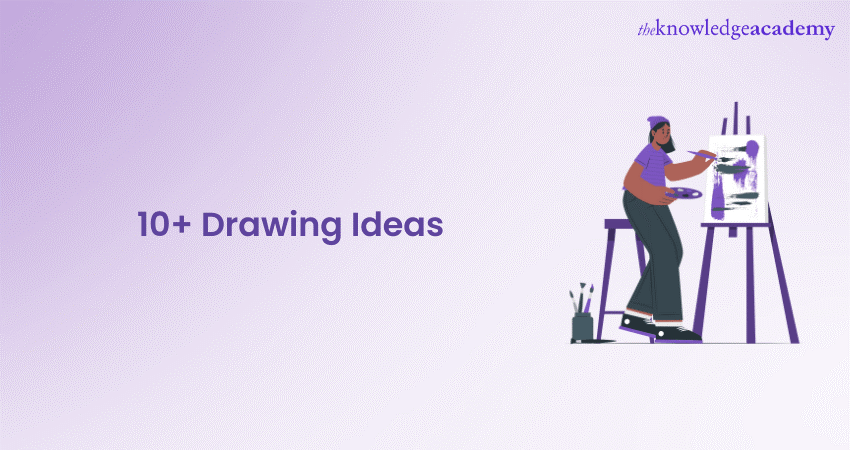
Embarking on a creative journey through drawing can be a thrilling and rewarding experience. Whether you're a seasoned artist or a beginner, trying out new Drawing Ideas can push your boundaries and spark fresh inspiration. In this blog, we'll explore more than 10 Drawing Ideas that can ignite your creativity and help you enjoy the process of artistic expression. Let’s dive in.
Table of Contents
1) What is the Four Kinds of Drawing?
2) 10+ Drawing Ideas
3) How Do 3D Drawings Work?
4) What Drawing is Trending Now?
5) Conclusion
What is the Four Kinds of Drawing?
The four main types of drawing are figure drawing, which captures human forms; cartooning, used for comics and animations; doodling, spontaneous and free-flowing sketches; and freehand drawing, created without tools for precise measurement. Each serves a different artistic or preparatory purpose in visual expression, showcasing the Benefits of Drawing by enhancing creativity, observation skills, and artistic development.
10+ Drawing Ideas
Here are the top 10+ Drawing Ideas for embarking on a creative journey.
Abstract Art
Abstract art is a form of artistic expression that does not attempt to represent an accurate depiction of visual reality. Instead of focusing on realistic portrayals, abstract artists use shapes, colours, forms, and gestural marks to achieve their desired effect. This form of art often emphasises the artist's emotional experience and allows for a wide range of interpretations by the viewer.
Here are some key aspects of abstract art:
1) Freedom of Expression: Abstract artists have the freedom to express themselves without the constraints of representing recognisable objects or scenes. This freedom allows for a more personal and subjective interpretation of the artwork.
2) Emphasis on Form and Colour: Abstract art often highlights the interplay of shapes, lines, and colours. Artists may use bold brushstrokes, geometric patterns, or a combination of various elements to create a visually engaging composition.
3) Emotional Impact: Many abstract artists aim to convey emotions, moods, or ideas through their work. Viewers are encouraged to explore their own feelings and reactions to the piece, fostering a unique and personal connection.
4) Open to Interpretation: Unlike representational art, abstract art invites viewers to interpret the meaning behind the artwork in their own way. This open-ended nature allows for a broad range of responses and encourages individual perspectives.
Portraiture
Portraiture is a form of visual art that focuses on capturing the likeness, personality, and character of a person or group of people through various artistic mediums. The aim of portraiture is to represent the subject in a recognisable manner, emphasising facial features, expressions, and sometimes the context of the individual's life. Portraits can be created using drawing, painting, photography, sculpture, or even digital media, and they have been a prominent and enduring genre throughout the history of art.
Here are some key elements and aspects of portraiture:
1) Facial Features: Portraits typically emphasise the facial features of the subject. Artists pay close attention to details such as eyes, nose, mouth, and the overall structure of the face to capture a person's likeness accurately.
2) Expression and Emotion: Portraits often seek to convey the subject's emotions, personality, or mood. Artists use various techniques to capture subtle nuances in facial expressions, body language, and even the play of light and shadow to evoke a specific emotional response from the viewer.
3) Composition and Pose: The composition of a portrait involves how the subject is positioned within the artwork. Artists consider factors such as the pose, framing, and background to create a visually appealing and meaningful representation.
4) Mediums and Styles: Portraits can be created using a variety of artistic mediums, including pencil, charcoal, oil paints, watercolours, photography, and digital tools. Different styles, from realistic and traditional to abstract and contemporary, allow artists to explore unique ways of portraying their subjects.
Level up your artistry! Join our Drawing Masterclass for an inspiring journey into the world of creativity!
Nature and Wildlife
Drawing nature and wildlife is a creative exploration that allows artists to capture the beauty, diversity, and intricacies of the natural world. This theme encompasses a broad range of subjects, including landscapes, plants, flowers, animals, and ecosystems.
Here's a closer look at the key aspects of drawing nature and wildlife:
1) Observation and Detail: Nature and wildlife drawing often begins with careful observation. Artists keenly study the details of their subjects, whether it's the delicate petals of a flower, the intricate patterns on an insect, or the fur and feathers of animals.
2) Botanical Illustrations: Botanical illustrations are a specialised form of nature drawing that focuses on the accurate representation of plant species. Artists in this genre aim to showcase the unique features, anatomy, and sometimes the life cycles of various plants.
3) Wildlife Sketching: Wildlife drawing involves depicting animals in their natural habitats. Artists may explore various techniques to convey the movement, behaviour, and unique characteristics of wildlife.
4) Landscape Drawings: Nature drawing often extends to landscapes, where artists portray scenes of mountains, forests, deserts, oceans, and skies. Landscape drawings aim to capture the essence of a natural setting, conveying its mood, atmosphere, and sometimes its seasonal changes.
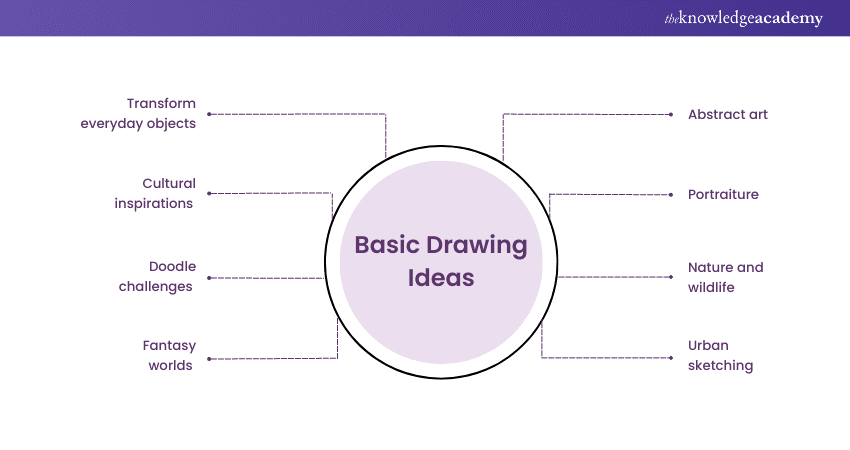
Urban Sketching
Urban sketching is a dynamic and on-location approach to drawing that focuses on capturing the essence of the built environment, cityscapes, and the everyday scenes of urban life. Artists who engage in urban sketching take their sketchbooks to the streets, documenting the architecture, people, and activities in a direct and immediate way.
Here are key aspects of urban sketching:
1) On-the-Spot Aketching: Urban sketching involves creating drawings on location, providing a direct and immediate connection between the artist and the subject matter. Artists often work quickly to capture the energy and details of a scene as it unfolds.
2) Architectural Focus: Buildings and urban architecture are prominent subjects in urban sketching. Artists capture the unique characteristics of city structures, from historic landmarks to everyday buildings, using techniques such as perspective drawing and attention to architectural details.
3) Street Life and People: Urban sketching often includes depictions of people going about their daily activities. Artists may sketch individuals in cafes, bustling street scenes, or public transportation, adding a human element to the urban landscape.
4) Exploration of Urban Spaces: Artists venture into various urban spaces, including parks, markets, squares, and waterfronts. This exploration allows for a diverse range of subjects and helps capture the distinct character of different neighbourhoods and city areas.
Ready to master design patterns? Elevate your skills with our Design Patterns Training. Register now for a transformative learning experience!
Fantasy Worlds
Fantasy world drawing involves creating imaginative and fantastical scenes that go beyond the constraints of reality. Artists delve into their creativity to design and illustrate worlds that are often inspired by mythology, folklore, literature, or entirely from their own imaginations.
Here are key aspects of drawing fantasy worlds:
1) Imagination and Creativity: At the core of fantasy world drawing is the freedom to let the imagination run wild. Artists have the liberty to invent landscapes, creatures, and entire civilisations that exist beyond the boundaries of the real world.
2) World-building: Fantasy artists engage in world-building, constructing detailed environments with unique geography, architecture, and atmospheres. This process includes designing fantastical cities, landscapes, and realms, each with its own rules and characteristics.
3) Mythical Creatures and Characters: Fantasy worlds often feature mythical creatures, legendary beings, and fantastical characters. Artists have the opportunity to bring to life creatures like dragons, unicorns, fairies, and other imaginative entities, adding a sense of wonder to their drawings.
4) Magic and Enchantment: Magic and enchantment are integral elements of fantasy world drawing. Artists can explore the use of magical elements, spells, and enchanted objects to add a sense of mystery and intrigue to their creations.
Doodle Challenges
Doodle challenges are a creative and often spontaneous form of artistic expression that involves creating small, simple drawings known as doodles. These challenges typically provide prompts or themes to inspire artists, encouraging them to explore their creativity in a lighthearted and fun manner.
Here are key aspects of doodle challenges:
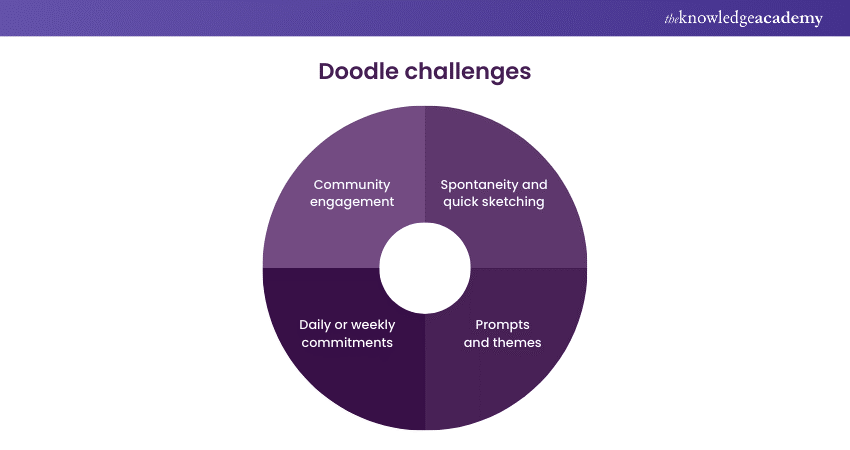
1) Spontaneity and Quick Sketching: Doodle challenges are characterised by their spontaneous nature. Artists are encouraged to create quick, unplanned sketches without overthinking or focusing on intricate details.
2) Prompts and Themes: Doodle challenges often come with prompts or themes to inspire artists. These prompts can be words, phrases, or visual cues that serve as a starting point for the doodles.
3) Daily or Weekly Commitments: Many doodle challenges are structured as daily or weekly commitments. Participants are encouraged to create a doodle based on the given prompt each day or week.
4) Community Engagement: Doodle challenges often thrive within a community setting. Artists share their doodles on social media platforms using specific hashtags or participate in online forums where they can connect with fellow creators.
Unleash your creativity with our Logo Design Training! Elevate your skills and craft impactful logos!
Cultural Inspirations
Drawing inspired by cultural themes involves capturing the rich and diverse elements of various cultures, including traditions, customs, symbols, clothing, architecture, and more. Cultural inspiration in drawing serves as a means to celebrate, preserve, and share the unique aspects of different societies.
Here are key aspects of drawing with cultural inspirations:
1) Cultural Diversity: Cultural inspiration in drawing embraces the vast diversity of human cultures around the world. Artists may choose to explore a specific culture deeply or draw inspiration from multiple cultures to create a fusion of elements.
2) Traditional Attire and Symbols: Artists often depict traditional clothing, accessories, and symbols that are significant within a particular culture. These elements can convey a sense of identity, history, and values associated with the community.
3) Ceremonies and Celebrations: Drawings inspired by cultural themes may capture the spirit of ceremonies, festivals, and celebrations. Artists have the opportunity to convey the joy, rituals, and vibrant colours associated with cultural events.
4) Architecture and Landscapes: Cultural inspiration extends to the representation of unique architectural styles and landscapes associated with different regions. Artists may draw iconic buildings, historical landmarks, or natural scenery that reflects the cultural identity of a place.
Transform Everyday Objects
Transforming everyday objects through drawing involves taking ordinary, mundane items and reimagining them in a creative and often fantastical way. This drawing concept encourages artists to see the potential for imagination and innovation in the familiar objects that surround us daily.
Here are key aspects of transforming everyday objects through drawing:
1) Creativity and Imagination: The essence of transforming everyday objects lies in the artist's creativity and imagination. Artists are encouraged to look at common objects with fresh eyes, envisioning them in ways that go beyond their usual functions or appearances.
2) Conceptual Innovation: Artists may choose to transform everyday objects by infusing them with new concepts, functions, or meanings. This could involve turning a simple household item into a fantastical gadget or reinterpreting its purpose in a surreal or abstract manner.
3) Visual Metaphors: Transforming everyday objects allows for the use of visual metaphors. Artists may use objects to symbolise abstract concepts, emotions, or societal issues, adding layers of meaning to their drawings.
4) Combining Elements: Artists often experiment with combining elements from different objects to create hybrid or imaginary forms. This process involves merging the characteristics of various everyday items to generate entirely new and unique visual compositions.
Ignite your creativity with Sketchbook Essential Training! Uncover the secrets to expressive sketching. Join now and bring your ideas to life!
Surrealism
Surrealism is an artistic and literary movement that emerged in the early 20th century, characterised by a fascination with the irrational, the dreamlike, and the unconscious mind. Surrealist art seeks to explore the realms beyond reality, often incorporating fantastical and hallucinatory elements.
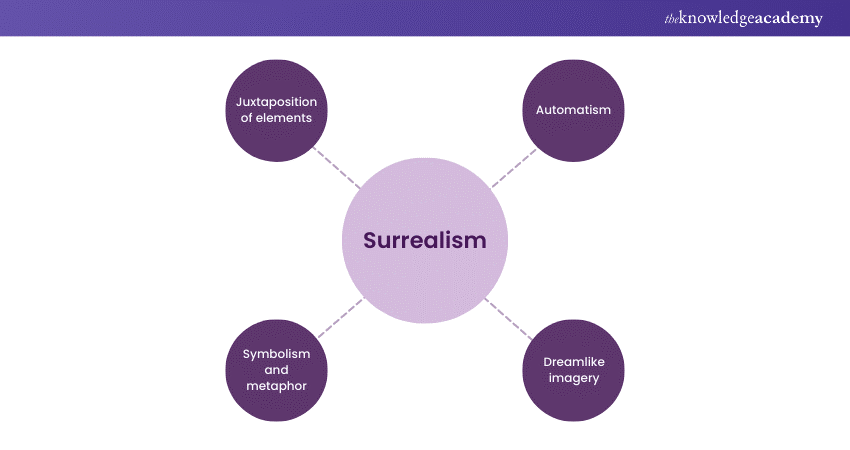
Key aspects of surrealism in art include:
1) Automatism: Surrealist artists often employed a technique called automatism, which involves allowing the hand to move freely without conscious control. This technique was believed to tap into the artist's subconscious, revealing thoughts and images buried in the mind.
2) Dreamlike Imagery: Surrealist art frequently features dreamlike and otherworldly imagery. Artists drew inspiration from dreams, fantasies, and the irrational aspects of the mind, creating scenes that defy logic and challenge the viewer's perceptions.
3) Symbolism and Metaphor: Surrealist works are rich in symbolism and metaphor. Everyday objects are often presented in unexpected contexts or combined in unusual ways to convey deeper meanings. This use of symbolism invites viewers to interpret the artwork on a symbolic level.
4) Juxtaposition of Elements: Surrealism often involves the juxtaposition of disparate elements. Artists combine unrelated objects, scenes, or creatures in unexpected ways, creating a sense of disorientation and prompting viewers to question the conventional boundaries of reality.
Scientific illustrations
Scientific illustrations are visual representations of scientific subjects, often used to convey complex information in a clear and accurate manner. These illustrations serve to communicate scientific concepts, processes, or specimens to a diverse audience, including researchers, students, and the general public.
1) Accuracy and Precision: Scientific illustrations prioritise accuracy and precision. Artists strive to represent scientific subjects with a high level of detail and correctness, ensuring that the illustrations align with scientific observations and data.
2) Clarity and Communication: The primary goal of scientific illustrations is to communicate complex scientific information in a clear and accessible manner.
3) Observational and Reference Value: Scientific illustrators often work closely with scientists, using direct observation, specimens, and reference materials to create their illustrations.
4) Educational Tools: Scientific illustrations are widely used as educational tools in textbooks, research papers, museums, and classrooms.
Dive into the world of digital art! Join our Digital Painting Masterclass and elevate your skills!
Storyboarding
Storyboarding is a visual planning technique used in various creative industries, such as filmmaking, animation, advertising, and video game design. It involves creating a sequence of drawings or images in chronological order to outline the key elements of a story or project.
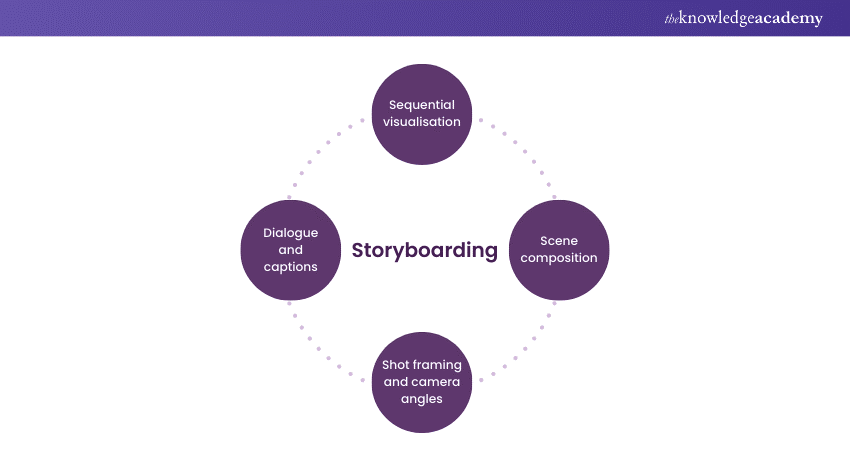
Here are key aspects of storyboarding:
1) Sequential Visualisation: Storyboards consist of a series of sequential images, each representing a specific moment or scene in a narrative. These images are arranged in chronological order, providing a visual roadmap for the progression of the story.
2) Scene Composition: Each storyboard frame typically includes sketches or drawings that depict the composition of a scene. This includes details such as character placement, facial expressions, background elements, and any important visual information necessary for understanding the narrative.
3) Shot Framing and Camera Angles: Storyboarding is crucial for planning the visual aspects of cinematography. It involves decisions about shot framing, camera angles, and transitions between scenes.
4) Dialogue and Captions: In addition to visual elements, storyboards often include dialogue or captions. These annotations provide information about the spoken lines, sound effects, music, or any other audio elements that accompany the visuals.
How Can I Perfect my Drawing?
Tips to improve drawing:
1) Practice Daily: Consistency improves skills
2) Sketch Real Life: Observe and draw surroundings
3) Focus on Depth & Light: Master shadows and perspective
4) Try New Mediums: Experiment with different tools
How Do 3D Drawings Work?
3D drawings create the illusion of depth on a flat surface using perspective, shading, and proportions. Artists use vanishing points, light, and shadow to add realism. Techniques like isometric, linear, and atmospheric perspective help achieve a 3D effect, making object appear lifelike and accurate in architectural, and artistic sketches.
What Drawing is Trending Now?
Trending drawing styles in early 2025 include Flat Design, which focuses on simplicity, making it a favourite in digital media. Pixel Art continues to gain popularity for its nostalgic appeal, often seen in digital illustrations. Anatomical Illustrations, inspired by artists like Nychos, blend artistic expression with scientific detail, and are often featured in events like World Art Day.
Conclusion
From the freedom of abstract art to the precision of scientific illustrations, each drawing idea offers a unique avenue for creative expression. The blog has delved into 10+ Drawing Ideas such as portraiture, nature and wildlife, urban sketching, fantasy worlds, doodle challenges, cultural inspirations, transforming everyday objects, surrealism, and storyboarding.
Join our Animation and Design Training for a journey into the world of dynamic creativity!
Frequently Asked Questions
What are the Other Resources and Offers Provided by The Knowledge Academy?

The Knowledge Academy takes global learning to new heights, offering over 3,000 online courses across 490+ locations in 190+ countries. This expansive reach ensures accessibility and convenience for learners worldwide.
Alongside our diverse Online Course Catalogue, encompassing 19 major categories, we go the extra mile by providing a plethora of free educational Online Resources like News updates, Blogs, videos, webinars, and interview questions. Tailoring learning experiences further, professionals can maximise value with customisable Course Bundles of TKA.
Upcoming Office Applications Resources Batches & Dates
Date
 Animation Course
Animation Course
Fri 2nd May 2025
Fri 4th Jul 2025
Fri 5th Sep 2025
Fri 7th Nov 2025






 Top Rated Course
Top Rated Course



 If you wish to make any changes to your course, please
If you wish to make any changes to your course, please


